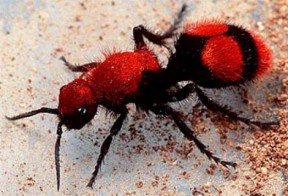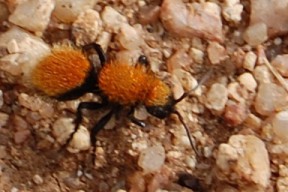 Red velvet ant: such a lovely name. Reading this, I’m sure a multitude of bucolic images come to mind. The problem is that each word of the description is erroneous.
Red velvet ant: such a lovely name. Reading this, I’m sure a multitude of bucolic images come to mind. The problem is that each word of the description is erroneous.
Naming an animal is not an exact science. The koala bear is not a bear but a marsupia. Crayfish and jellyfish have one particular thing in common: neither is a fish.
The red velvet ant is not an ant at all, but a wasp.
How do we know that? They have a slight constriction between their thorax and abdomen (perhaps where the term “wasp waist” comes from?) and they have straight antennae. Ants have elbow-shaped antennae.
 Red velvet? I would not dare you to stroke them to find out. Even the word “red” is misapplied, as this insect is part of the Mutillidae family, composed of more than 3,000 species – so they are just called velvet ants.
Red velvet? I would not dare you to stroke them to find out. Even the word “red” is misapplied, as this insect is part of the Mutillidae family, composed of more than 3,000 species – so they are just called velvet ants.
At the Placerita Canyon Nature Center, they can be found in a beautiful array of colors: red, white, gray and orange.
In the insect world, bright coloration usually means “danger.” Do not come near. That’s called an aposematic signal. The reason it’s a not good idea to feel them to see how velvety those “ants” are is indicated by their other nickname.
Cow killers.
How did they get that name? Adult velvet ants feed on nectar and water, so they are often found in pastures, gardens and fields where cows typically graze. In this environment, there must have been some cattle being stung at some point, and showing signs of the agonizing pain from the sting, even if it is short-lived reaction.
I found a personal testimony from a scientist, Don Manley, professor emeritus at Clemson University. He studied these insects for years and was finally stung one day. This is a man who had worked with bees, ants and wasps his whole life and had been stung many times before. But nothing ever came close to the pain he experienced with the velvet ant sting.
“For 20 minutes, I just wanted to die and get it over with,” he said. “I had worked with them for 20 years before I finally was stung. And I will not be stung by one again.”
 Only the female can sting. The stinger is a sex organ called an ovipositor. It is long, like a needle, concealed at the tip of the abdomen, and can be moved easily in all directions. They are not aggressive insects, but if they are threatened, this weapon is very effective.
Only the female can sting. The stinger is a sex organ called an ovipositor. It is long, like a needle, concealed at the tip of the abdomen, and can be moved easily in all directions. They are not aggressive insects, but if they are threatened, this weapon is very effective.
The sexes look different. The male is much larger and has two pairs of transparent wings, where females do not. Often it is impossible to identify both male and female as belonging to the same species except when they are caught while mating.
The male seeks a mate by looking for one, and pheromones are also believed to play a role. The male is much larger; he grabs the female and carries her in the air while mating, and drops her off when he is finished. One interesting detail: Both sexes squeak during the mating process.
Both sexes have a stidulitum on the metasona, and that helps them produce this squeaky noise when alarmed. That is another defense mechanism telling you to stay away. It must work well, as this insect does not have any known predators.
They are not seen in large numbers, but it is better to put on shoes and not step on one accidentally. Do not think you can easily swat them away. Their exoskeleton is unusually hard, and entomologists have had problems trying to pierce them with metal pins to be able to put them in displays.
This hard shell protects them during the digging they have to do at nesting time. The female looks for a bumble bee nest in the ground. She digs through the soil and breaks through the nest wall to the nesting chamber made of wax cups. There she deposits an egg on the bumble bee larvae which will soon develop as a white legless grub and feed on the larvae. It will go through a few phases before forming a pupa. At this point, the bumble bee will die.
I love the world of insects. It is full of hair-raising details, and very graphic and horrible pictures come to mind when you read those details. What is especially interesting is that you are rarely able to witness such actions, so learning about them opens a world of wonder and sick fascination. There is so much to learn and discover.
This is an unusual insect, perhaps, but very striking. We seem to see more of them in July, August and September, and there are still plenty of those warm days to come in the next few weeks. Cow killer, donkey killer? Just observe them with respect – and some distance – and nobody will get hurt.
Evelyne Vandersande has been a docent at the Placerita Canyon Nature Center for 27 years. She lives in Newhall.
Fuzzy Wuzzy Wasn't an Ant | Commentary by Evelyne Vandersande